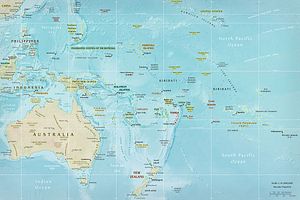The release of Australia’s new Foreign Policy White Paper last week has provided a solid signal as to how Australia sees itself approaching the world in the forthcoming decades. The paper aims to defend the liberal values that have served the country well, and seeks to negotiate the evolving regional power balance by desiring that change develops within a stable, agreed upon, open and cooperative architecture.
Importantly, the paper dedicated a chapter to Australia’s role within the Pacific (grouping Timor-Leste in alongside the conventional Oceania region). As the dominant actor in the Oceania region, this is where Australia can best exert its influence to maintain a liberal international order. Greater engagement in the region to provide “support for a more resilient Pacific and Timor-Leste” is deemed an “essential component of Australia’s continued security and prosperity.”
This is no great shift in Australia’s policy thinking towards the Pacific, but a heightened recognition of the importance of maintaining Australia’s status as the dominant regional actor. While previous security concerns in the Pacific have focused on the internal instability of Pacific states, this has shifted to a recognition of China’s increasing influence as a threat to Australia’s regional dominance.
As China hopes to convert its rapid economic rise into significant regional influence, it will play a greater role in the Pacific, beyond its game of bargaining for diplomatic recognition with Taiwan. This engagement has often been clumsy and heavy-handed as it has been simply motivated by the animus with Taiwan. However, Chinese power in the region is bound to become more sophisticated as Beijing becomes more accustomed to the tools at its disposal, and Australia’s engagement will have to evolve in response.
At the core of this response is the support for the development of Pacific Island states, including the further integration of the Pacific Island states into the Australian and New Zealand economies. This objective has primarily been pursued through the PACER Plus free trade agreement, although the agreement remains stilted without the participation of Papua New Guinea and Fiji, the two largest regional economies after Australia and NZ. However, within the negotiations for the agreement has come a greater recognition by Australia that greater labor mobility is arguably the most impactful approach to the development of Pacific Island states.
This remains not just an economic advantage, but increasingly a moral imperative due to the existential threats to many Pacific Island states caused by rising sea levels. The recently launched Pacific Labor Scheme for citizens of Nauru, Kiribati, and Tuvalu can be seen as the vanguard of a more generous access to labour entitlements within Australia for Pacific states. This scheme indicates that the government does have an eye on Australia’s regional responsibilities even if its domestic pronouncements fluctuate between shyness and ignorance on matters related to Climate Change.
While it is a positive development for the Australian government to provide greater access to Australia’s labor market, the country still lags well behind New Zealand in this regard. However, the recognition of the need for greater labor mobility, and the new security agreements Australia had reached with Nauru and Tuvalu, could indicate there is some movement towards an arrangement of “free association” between these states and Australia.
While the White Paper recognizes the developmental difficulties facing Pacific Island states, the document seems reluctant to discuss Australia’s aid program as an essential component to its foreign policy (despite maintain existing levels of aid). Linking the aid program to regional economic development, and the wider aims of stability and liberal values should have been something the government is willing to signal to the Australian public.
Despite great gains in the reduction of poverty through Asia, it remains a persistent problem throughout the Pacific, and a problem that could become further entrenched as many islands lose key resources due to the effects of climate change. A country like Nauru is propped up by Australia’s offshore detention center, and will have very limited sources of income after current detainees are finally relocated. PNG and Timor-Leste both have significant problems with malnutrition, and the region as a whole has increasing rates of adult diabetes due to a shift away from traditional diets towards highly processed imported foods.
Tackling these issues is not something the Australian public would begrudge, and the government underestimates its citizens if it feels the need to hide its foreign aid agenda from it. Yet in launching the White Paper neither the prime minister, foreign minister nor trade minister discussed the subject at all, diminishing the importance of Australia’s Pacific engagement that the White Paper itself strives to promote.
As a power of some significance, Australia may see itself as playing a larger role in evolving balance of power in the greater Indo-Pacific region. This is an understandable and essential impulse, highly important to Australia’s interests. Yet this should not preclude it from furthering its engagement and responsibilities within the south Pacific, where its ability to have a more direct impact is significant. The Foreign Policy White Paper expresses an understanding of this, it remains to be seen whether Australia’s actions will extend from this.

































